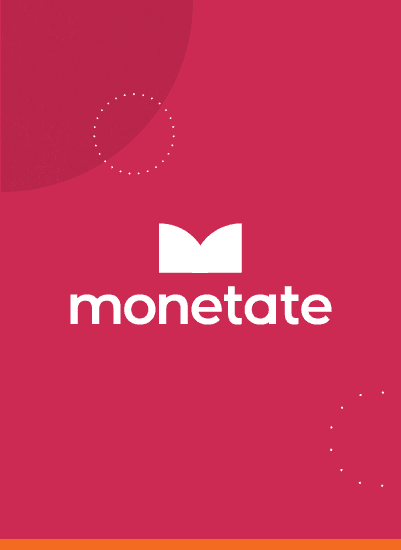
Personalize the Post-Click Experience and Improve ROAS With Audience Creation Tool
As a marketer, you have most likely dealt with the challenge of creating highly targeted landing experiences for paid media campaigns. But, since these campaigns are typically managed by ads teams, you might not have the visibility needed to create optimal landing experiences. This can often result in web experiences that are totally disconnected from the advertising message.
Enter: AdLink.
AdLink is a new audience creation tool that enables marketers like you to efficiently personalize onsite experiences for traffic from paid media campaigns.
Using the personalization capabilities of Monetate, AdLink is able to break down the long-standing silos that have existed between marketing and advertising. As a result, you can create a personalized customer experience that is more likely to keep visitors engaged and more likely to get them to convert post-click.

AdLink unifies your advertising and marketing channels in one integrated platform
Adlink pulls data from Google, Facebook, and other paid media sources to create automated audience segments. These segments can then be used by marketers to target audiences for personalized post-click experiences across a site.
By keeping already interested consumers engaged with a relevant post-click journey, retailers will be able to deliver more performance per ad dollar spent.
Post-click experiences
With Adlink, marketers will have an easier and more scalable way to connect their acquisition efforts to their conversion efforts to drive true end-to-end campaign optimization. Contact our Personalization Experts at Monetate to learn more.
Industry Trends in Post-Click Experience
The digital marketing industry is undergoing a significant transformation, with post-click experience emerging as a pivotal factor in customer engagement and conversion optimization. As brands continuously strive for deeper connections with their audience, the focus on delivering personalized and compelling post-click experiences has intensified.
Recent years have seen a notable uptick in technologies that facilitate individualized marketing experiences, significantly post-click. Here are a few prevalent trends shaping the post-click experience landscape:
- Hyper-Personalization: Brands are increasingly leveraging artificial intelligence (AI) and machine learning (ML) to analyze user behavior and deliver highly personalized content and recommendations, aiming to align closely with individual consumer preferences and expectations.
- Interactive Content: To enhance user engagement post-click, marketers are investing in interactive content, including quizzes, polls, calculators, and augmented reality experiences. These interactive elements offer users value and entertainment, encouraging longer page visits and higher conversion rates.
- Responsive & Adaptive Design: With the variety of devices and screen sizes used by consumers today, having a responsive and adaptive design is non-negotiable. This trend ensures that post-click content is accessible, functional, and visually appealing across all devices, from desktops to smartphones.
- Data Privacy Considerations: With the enactment of data protection laws like GDPR and CCPA, there’s a growing emphasis on ethical data collection and processing practices. Marketers are being more transparent and responsible in handling consumer data, building trust and compliance while crafting personalized experiences.
- Performance Analytics & Optimization: Marketers are extensively utilizing analytics tools to measure and optimize the performance of post-click experiences. Through continuous testing and data-driven adjustments, brands are refining their post-click strategies to maximize engagement and conversion.
Why Personalized Marketing Matters
In an era where consumers are inundated with marketing messages, personalized marketing stands out as a crucial strategy for capturing attention and fostering brand loyalty. Here’s why personalized marketing is indispensable in today’s digital landscape:
- Enhanced User Engagement: Personalized content resonates more deeply with consumers as it aligns with their interests, needs, and preferences. When users find content that speaks directly to them, they are more likely to engage, leading to increased time spent on page and higher click-through rates.
- Increased Conversion Rates: According to Econsultancy, 93% of companies see an uplift in conversion rates from personalization. Personalized call-to-actions (CTAs) and content are more effective in prompting users to take desired actions, ultimately driving sales and conversions.
- Improved Customer Retention: Personalization fosters a sense of value and recognition among customers. When consumers feel understood and appreciated, they are more likely to develop loyalty toward a brand, resulting in repeat purchases and long-term customer relationships.
- Efficient Marketing Spend: By targeting specific audience segments with personalized messages, brands can achieve more with less. This precision in targeting reduces wasted ad spend on disinterested consumers, ensuring that marketing budgets generate better returns on investment (ROI).
- Competitive Differentiation: In a saturated market, personalization serves as a differentiator that sets brands apart from their competitors. Consumers are more likely to choose brands that offer tailored experiences, as it reflects a deeper understanding and consideration of their unique needs and expectations.
Personalized marketing is not just a trend but a fundamental approach that brands must adopt to connect effectively with their audiences in the digital age. The investment in technologies and strategies that enable personalization, particularly in post-click experiences, is crucial for marketing success and sustainable business growth.